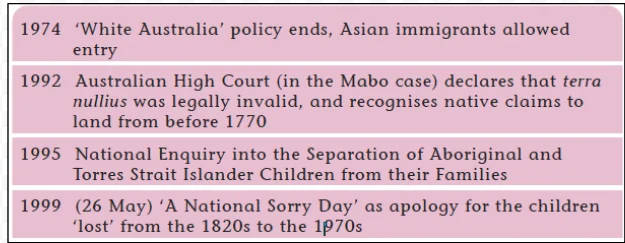![]() 15 Jul 2024
15 Jul 2024
Human habitation in Australia has an extensive history, with aboriginal societies known as the ‘Aborigines’ arriving on the continent over 40,000 years ago. These early inhabitants are believed to have migrated from New Guinea. According to the natives’ traditions, they had always been in Australia, and they referred to the past centuries as the ‘Dreamtime,’ a concept challenging for Europeans to grasp as it blurs the distinction between past and present.
Linguistic Diversity: In the late eighteenth century, Australia was home to between 350 and 750 native communities, each with its distinct language. Even today, around 200 of these languages are still spoken.


| A Description of the Sydney Area in 1790
‘Aboriginal production had been dramatically disturbed by the British presence. The arrival of a thousand hungry mouths, followed by hundreds more, put unprecedented pressure on local food resources. So what would the Daruk people have thought of all this? To them such large-scale destruction of sacred places and strange, violent behavior towards their land was inexplicable. The newcomers seemed to knock down trees without any reason, for they were not making canoes, gathering bush honey or catching animals. Stones were moved and stacked together, clay dug up, shaped and cooked, holes were made in the ground, large unwieldy structures built. At first they may have equated the clearing with the creation of a sacred ceremonial ground…Perhaps they thought a huge ritual gathering was to be held, a dangerous business from which they should steer well clear. There is no doubt the Daruks subsequently avoided the settlement, for the only way to bring them back was by an official kidnapping.’ – (P. Grimshaw, M. Lake, A. McGrath, M. Quarterly, Creating a Nation) |
Parallels in Colonization: The story of European colonization in Australia shares striking similarities with the American experience.


Unveiling the Silence: In 1968, the renowned anthropologist W.E.H. Stanner delivered a groundbreaking lecture titled “The Great Australian Silence,” which called attention to the silence of historians regarding the indigenous peoples of Australia.

| Must Read | |
| Current Affairs | Editorial Analysis |
| Upsc Notes | Upsc Blogs |
| NCERT Notes | Free Main Answer Writing |
Australia‘s journey from colonization and indigenous displacement to a modern multicultural society highlights the resilience of its native communities. Acknowledging past injustices and fostering cultural respect, continues to evolve towards inclusivity and human rights recognition.
| Related Articles | |
| Relations of British India with Neighboring Countries | Human Rights Abuse in India |
| POPULATION IN INDIA | European Parliament Elections |
<div class="new-fform">
</div>